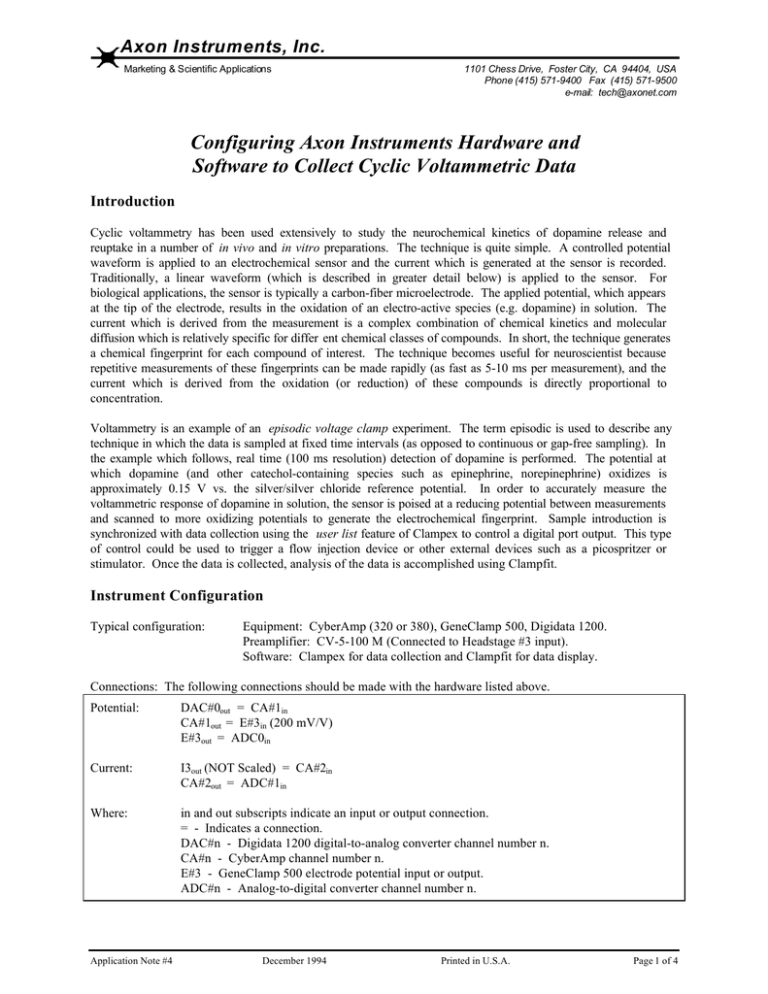Configuring Axon Instruments Hardware and Software to Collect
advertisement

Axon Instruments, Inc. Marketing & Scientific Applications 1101 Chess Drive, Foster City, CA 94404, USA Phone (415) 571-9400 Fax (415) 571-9500 e-mail: tech@axonet.com Configuring Axon Instruments Hardware and Software to Collect Cyclic Voltammetric Data Introduction Cyclic voltammetry has been used extensively to study the neurochemical kinetics of dopamine release and reuptake in a number of in vivo and in vitro preparations. The technique is quite simple. A controlled potential waveform is applied to an electrochemical sensor and the current which is generated at the sensor is recorded. Traditionally, a linear waveform (which is described in greater detail below) is applied to the sensor. For biological applications, the sensor is typically a carbon-fiber microelectrode. The applied potential, which appears at the tip of the electrode, results in the oxidation of an electro-active species (e.g. dopamine) in solution. The current which is derived from the measurement is a complex combination of chemical kinetics and molecular diffusion which is relatively specific for differ ent chemical classes of compounds. In short, the technique generates a chemical fingerprint for each compound of interest. The technique becomes useful for neuroscientist because repetitive measurements of these fingerprints can be made rapidly (as fast as 5-10 ms per measurement), and the current which is derived from the oxidation (or reduction) of these compounds is directly proportional to concentration. Voltammetry is an example of an episodic voltage clamp experiment. The term episodic is used to describe any technique in which the data is sampled at fixed time intervals (as opposed to continuous or gap-free sampling). In the example which follows, real time (100 ms resolution) detection of dopamine is performed. The potential at which dopamine (and other catechol-containing species such as epinephrine, norepinephrine) oxidizes is approximately 0.15 V vs. the silver/silver chloride reference potential. In order to accurately measure the voltammetric response of dopamine in solution, the sensor is poised at a reducing potential between measurements and scanned to more oxidizing potentials to generate the electrochemical fingerprint. Sample introduction is synchronized with data collection using the user list feature of Clampex to control a digital port output. This type of control could be used to trigger a flow injection device or other external devices such as a picospritzer or stimulator. Once the data is collected, analysis of the data is accomplished using Clampfit. Instrument Configuration Typical configuration: Equipment: CyberAmp (320 or 380), GeneClamp 500, Digidata 1200. Preamplifier: CV-5-100 M (Connected to Headstage #3 input). Software: Clampex for data collection and Clampfit for data display. Connections: The following connections should be made with the hardware listed above. Potential: DAC#0out = CA#1in CA#1out = E#3in (200 mV/V) E#3out = ADC0in Current: I3out (NOT Scaled) = CA#2in CA#2out = ADC#1in Where: in and out subscripts indicate an input or output connection. = - Indicates a connection. DAC#n - Digidata 1200 digital-to-analog converter channel number n. CA#n - CyberAmp channel number n. E#3 - GeneClamp 500 electrode potential input or output. ADC#n - Analog-to-digital converter channel number n. Application Note #4 December 1994 Printed in U.S.A. Page 1 of 4 Software Configuration Clampex is used to define the potential waveform applied to the electrode and to collect the resulting data. In addition, digital lines to sample injection devices, such as a picospritzer, can be configured and be synchronized with the data collection process. The following sections describe the Clampex configuration information required to run cyclic voltammetry. Bolded letters indicate user input. Figures in the text show the details of each screen involved in configuring the software. Once you have configured your system properly, you should save your settings in a parameter file. Under Configure, Hardware: Before data can be collected, the hardware must be specified. The figure to the right is a typical configuration for the specified Axon hardware. Note the configuration on your system may be different. Under Parameters, Acquisition: In this example, the potential applied to the working electrode (sensor) is ramped in a linear fashion with respect to time. This is analogous to a voltage clamp experiment. In this configuration the Digidata 1200 samples data on channels 0 and 1 at 0.1 second intervals and repeats the measurement 100 times. With the hardware configured as indicated above, the applied potential will be returning on A/D channel 0 and the current on A/D channel 1. Each episode consists of 256 data points/channel. Under Parameters, Waveform: This section shows how to define a potential ramp from -0.4 to 1.4 V and back to -0.4 V. The voltage applied to the electrode is generated with DAC 0 and applied to the E#3 (200 mV/V) input of the GeneClamp 500. To calculate the potential scan rate, note that 124 points are used to scan a 1.4 volt range. As defined in the previous window, each point represents 24 µs and thus the scan rate is 470 V/s (1.4 V /(124 points * 24 µs/point)). Application Note #4 December 1994 Printed in U.S.A. Page 2 of 4 Under Parameters, Scaling: For the GeneClamp 500, the voltage applied to the electrode is scaled by a factor of 200 mV/V. Since the recorded voltage is a factor of five times greater than the applied voltage, the scaling of the signal is done by setting the acquisition scaling factor on channel zero. The GeneClamp BNC connection I3 out carries the current from the electrode. This current, measured at DAC 0, is scaled by a factor determined by the preamplifier used. For the CV-5-100 M, the gain is 10 nA/V (or 0.1 V/Units). Note that the output channels have been scaled for correct output. Under Configure, CyberAmp, Settings: In cyclic voltammetry, a true linear ramp is employed. Using the CyberAmp, the programmed waveform can be low-pass filtered to closely resemble a true linear waveform. This can be done empirically by setting the waveform filter (Channel #1) so that minimal distortion of the recorded triangle wave is observed. Under these conditions, a cutoff frequency of 6000 Hz can safely be employed without distortion of the signal. Under Parameter, Userlist: To precisely control the sample introduction, a userlist is defined. The userlist is used to control the digital output lines of the Digidata 1200. As defined below, background scans are collected for a 0.5 seconds and a signal is introduced for 3.4 s. The final input of the userlist forces the output of the digital line back to its initial value of zero. Note that data is collected for a total of 10 seconds (100 episodes at 0.1 seconds) to monitor the electrode response after the termination of the event triggered by the user list. Application Note #4 December 1994 Printed in U.S.A. Page 3 of 4 Collecting Data Under Configure, Fastloading: In this example, the background current is first allowed to stabilize for 100 cycles and then the data, with sample injection, is performed. Two parameters sets are used. The first, CV01.BPA, is saved with the user list disabled. CV02.BPA is saved with the user list enabled. Fastloading is used to sequen tially run these files and collect the data set of interest (under control of CV02.BPA). To activate the conditioning and collection scans, Ctrl-F1 is used. Note the link allows CV02 to be loaded and the data collected. With a 10 µm carbon-fiber disk electrode, you should expect to see a stabilized current response similar to that shown on the right. When the program is under fast loading control, the bottom portion of the screen will indicate fast loading. Data collected in Dulbecco’s phosphate buffered media (no calcium or magnesium) using a 10 µm carbon-fiber microelectrode. Note the parameter set installed is indicated in the upper left corner of the screen (CV01). Effective scan rate 470 V/s. When the measurement is made in the presence of 10 µM dopamine, the signal is observed as a signal on top of the background current. In the next note, analysis of this data will be performed. Appearance of Clampex after data collection is complete. Data collected in Dulbecco’s phosphate buffered media (no calcium or magnesium) using a 10 µm carbon-fiber microelectrode in the presence of 10 µM dopamine. Parameter set: CV02. Application Note #4 December 1994 Printed in U.S.A. Page 4 of 4


